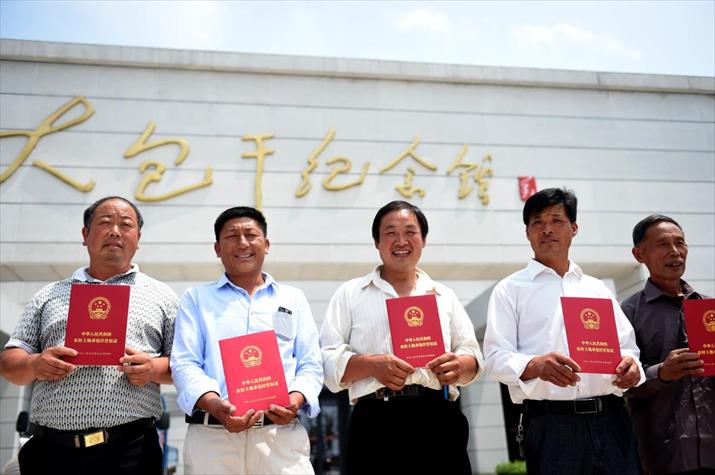| Business |
| Turning Weak Areas into New Growth Drivers | |
|
|
 Local farmers show off their farmland contract and management right certificates in Xiaogang Village, Anhui Province, on July 8, 2015 (XINHUA)
In the first quarter China registered year-on-year GDP growth of 6.9 percent, the highest rate within the most recent six quarters. Indicators such as power consumption, rail freight volume and producer price index (PPI) rebounded remarkably, while industrial added value, investment and job figures beat expectations. The drivers supporting China's economic growth are becoming stronger. Despite the good performance, we must be aware that China still faces pressure to maintain economic growth and its industrial structure needs to be further improved. In the medium and long term, it is necessary for China to intensify reform and innovation and unleash economic growth drivers, starting with bolstering weak areas. First, China should firmly advance land reform in rural areas. As industrialization and urbanization accelerate, slow rural land reform has become a major factor inhibiting China's economic growth. Some homesteads in rural areas are not efficiently used, and lacking a sound arrangement to reuse deserted homestead. As a result, land supplies are inadequate to support urbanization, and transfer of rural labor is impeded, affecting urban-rural integration. Therefore agricultural supply-side reform should start with rural land reform, and the government should, based on protecting farmers' rights and interests and ensuring the country's cultivated land area does not fall below the set minimum level of 120 million hectares, further break through institutional barriers to establish market-oriented mechanisms. In particular, China should advance the reform that will change the current system based on collective ownership of rural land and individual land contract and management rights into a new one featuring the separation of farmland ownership rights, contract rights and operating rights. The reform is facing many difficulties. Its success requires institutional innovation, amendment of related laws and regulations, and improvement of supporting mechanisms. The country should also overcome institutional barriers to boost the reform of collectively owned farmland use rights and homestead use rights in order to revitalize resources and assets in the countryside. In addition, China should establish systems to ensure deserted homesteads can be reused or transferred in return for compensation. For this purpose, incentive systems should be explored. Second, community finance should be steadily developed. A lot of Chinese enterprises, particularly small and micro-sized ones, are having difficulty securing financing. It is mainly because large and medium-sized enterprises have obtained too much bank credit, due to misallocation of financial resources, and have then invested heavily outside the real economy. Small and micro-sized enterprises or start-up businesses, meanwhile, are unable to get necessary financial support. Community finance, which will help build "capillaries" in the financial system and effectively serve every part of the economy, will become an important method to solve misallocation of financial resources. Developing community finance does not mean ordering traditional banks to set up outlets in communities. Rather, it requires bringing more financial services to communities through institutional innovation and guiding more financial resources to serve small and micro-sized businesses, self-employed individuals and households. In the future a large number of small and micro-sized commercial banks can be established through transformation of micro credit firms, peer-to-peer lending institutions and Internet lending platforms as well as purchasing of outlets from large banks. The government should formulate policies to support and regulate development of community finance. For instance, it should improve the credit guarantee system and realize full coverage of the deposit insurance system, in order to promote the development of community finance and prevent systemic financial risks. The author is a chief economist at the Bank of Communications, and this is an edited excerpt published in the Economic Daily Copyedited by Chris Surtees Comments to zhouxiaoyan@bjreview.com |
|
||||||||||||||||||||||||||||||
|